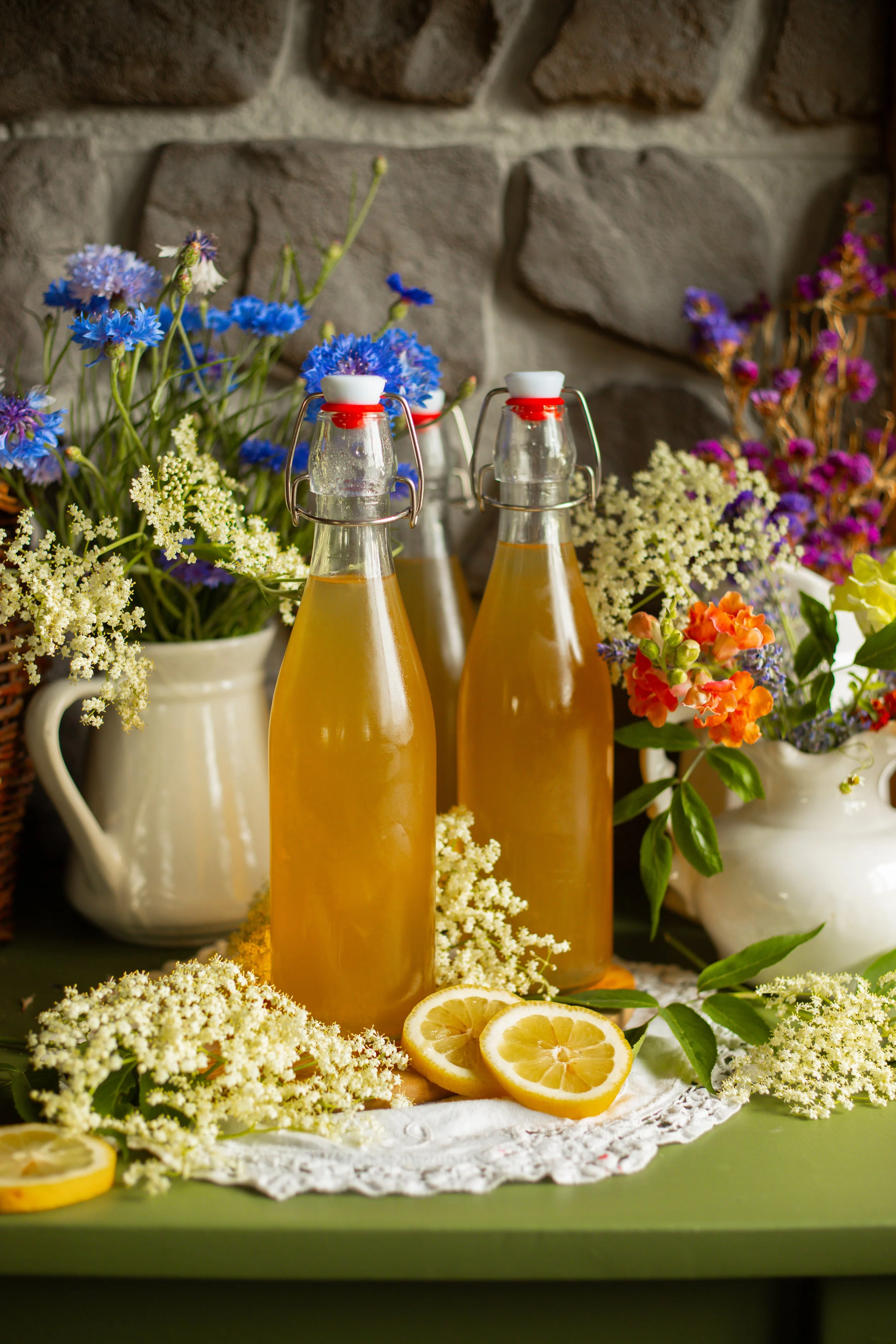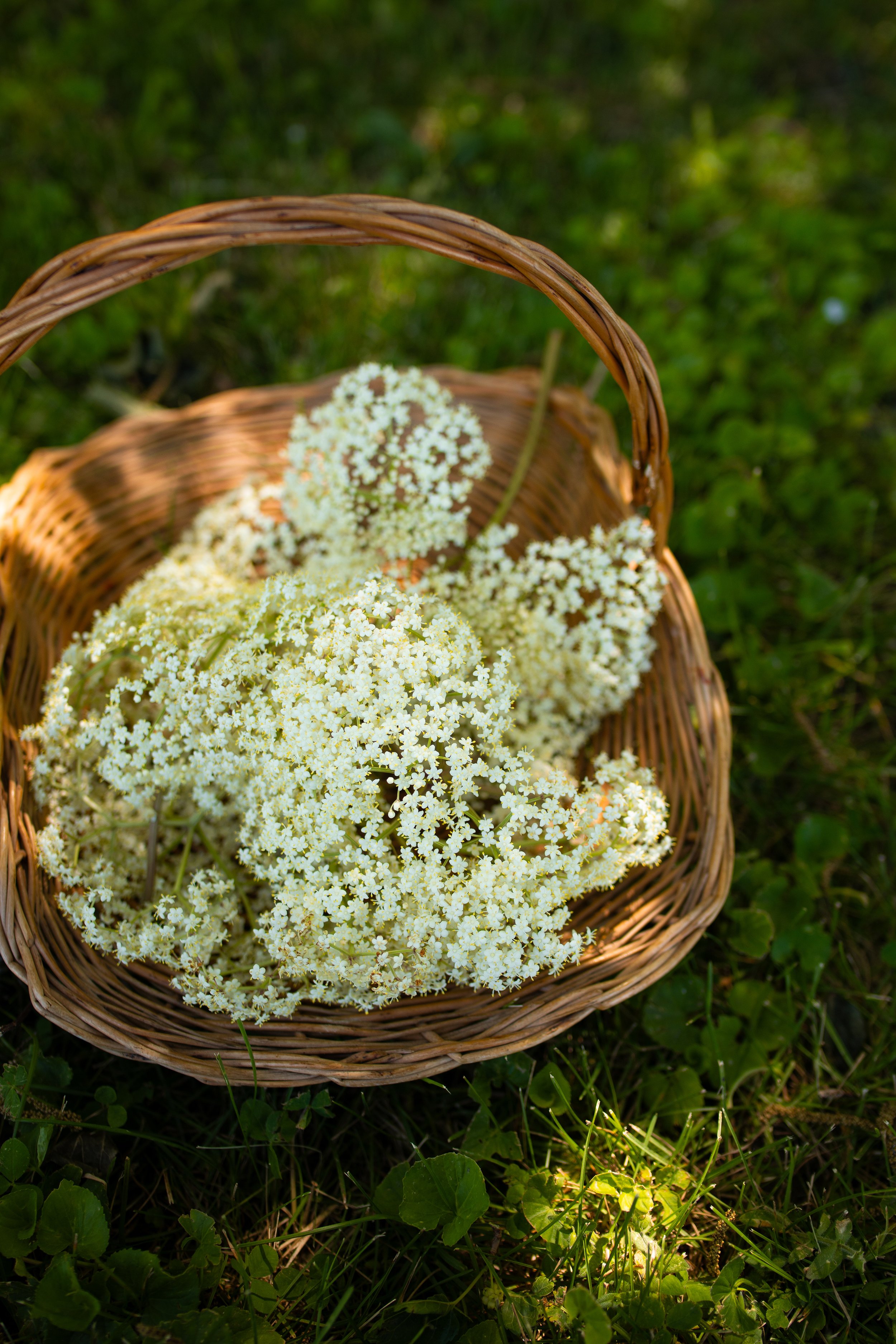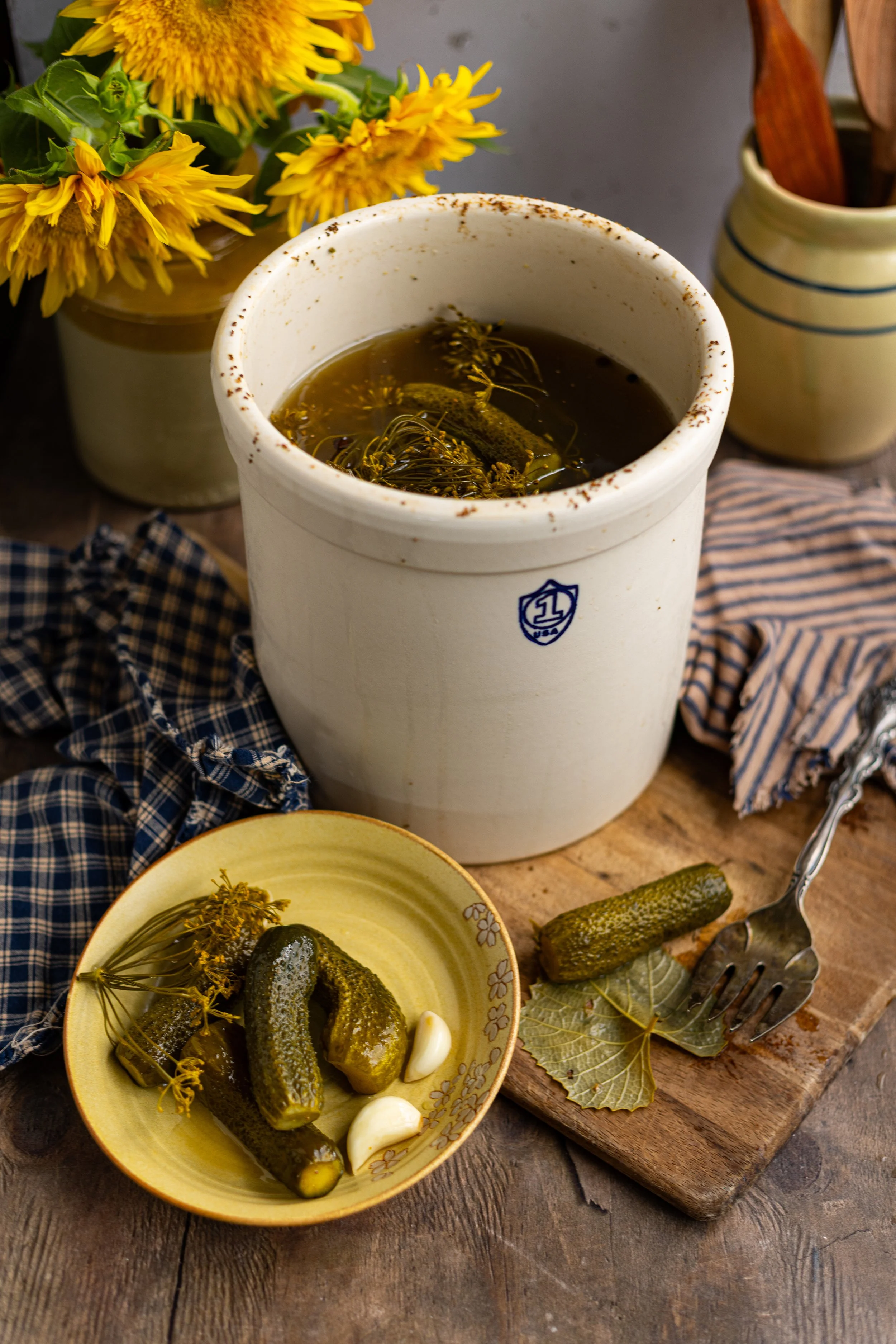Elderflower Cordial Recipe: How to Make, Bottle, & Preserve This Floral Syrup
This post may contain affiliate links, please see our privacy policy for more information.
This fragrant elderflower cordial recipe captures the delicate floral essence of early summer. Learn how to make, bottle, and preserve this syrup to flavor mixed drinks, make ice cream, infused whipped cream, and more.
Capturing Summer in a Bottle
Elderflowers have been foraged and used to make delicious summer recipes for centuries. By combining sugar, water, and lemons with elderflowers, you can make a seriously delicious Elderflower Cordial recipe. This delicious soft drink has been enjoyed since the time of the Ancient Romans and possibly earlier. It became popular in the Victorian Era, mostly in Northwestern Europe, and is still beloved by those who enjoy old-fashioned recipes and nostalgia. Elderflower cordial is sweet and syrupy, with a slightly floral and fruity flavor that is reminiscent of pears or even honey. You can use your homemade elderflower cordial to flavor tea and lemonade among other mixed drinks, make ice cream, whipped cream, and more.
This cordial recipe is non-alcoholic. It can, though, be added to alcoholic beverages to sweeten and flavor them. Elderflower cordial is simply made by steeping the elderflowers in a sugar solution with the addition of citric acid to preserve it for long periods of time.
Video: How to Make Elderflower Cordial (Foraging & Preserving Tutorial)
Best Elderflowers for Cordial
When working with elderflowers, you should only use fresh elderflowers from the Sambucus nigra variety. These are commonly found in North America and Europe.
You can learn how to gather your own flowers in my Ultimate Guide to Foraging for Elderflowers.
Look for fully opened blossoms that are creamy white and fragrant, like honey.
Avoid clusters with browning petals or strong bitter aromas, as they are past their peak.
Harvest on a hot, dry morning when the blossoms are at their most fragrant.
Gently shake off insects and avoid washing the flowers to preserve their pollen and flavor.
Because elderflowers are delicate, it is best to make your cordial the same day you harvest. They do not keep well after picking.
You can learn how to gather your own flowers in my Ultimate Guide to Foraging for Elderflowers.
Preservation tips for Cordial
Cordial is typically preserved as a bottled syrup using sterilized bottles and refrigeration.
Citric acid or lemon juice paired with sugar act as natural preservatives and help stabilize flavor and color.
For longer shelf life, you can freeze the cordial and enjoy later.
Canning Safety Notes
Elderflower cordial is not high-acid enough to can safely for long-term shelf storage without adjustments.
You can alternatively store your codial in the freezer for long-term storage. Be sure to leave 1-inch (2.5-cm) headspace in each jar or container for expansion.
Preserving Supplies You’ll Need
Before to begin making your elderflower cordial, you may need to gather some kitchen equipment. Here is what I used to make my homemade elderflower cordial:
Large Non-Reactive Pot. Use a pot made from stainless steel or enameled cast iron. Other types of materials such as aluminum, uncoated cast iron, and copper may react with the acidity in this recipe.
Citric Acid or Fresh Lemon Juice.
Fine Mesh Sieve. You will need this to strain the infused flower liquid.
Double Layered Cheesecloth. You will need this to squeeze excess liquid from the flowers.
Brewing Funnel. If you plan to use a swing top bottle, you may need to purchase a funnel that will fit in the top of the bottle. This set of bottles comes with two silicone brewing funnels that are easy to use and wash!
Swing Top Glass Bottles. Swing top bottles are by the far the easiest way to store cordial, especially if you plan to make a large amount to store away. I like to use 16 oz bottles as this seems to be the right amount that I enjoy using, but any size that you prefer will work.
Ingredients & Substitutions
Elderflowers. Elderflowers should be gathered on a hot, dry day and used quickly. The best flowers are the ones that are creamy-white in color and the sprays on each individual stem, or umbel, is opened.
Lemons. The citric acid in lemons helps to preserve the cordial and flavor it.
Sugar. I would suggest using a granulated sugar for this recipe, and any type will do. You can use honey, if you prefer. Any sugar that you substitute should be 1:1.
Water.
how to make elderflower cordial:
Step One: Begin by washing and sterilizing your 16 oz swing top bottles. You will want to keep the bottles hot in simmering water or your dish washer to avoid thermal shock.
Step Two: Next, prepare the elderflowers. The flowers should be processed quickly after harvesting. Shake off any potential insects that may be living on your flowers, but do not wash the flowers. This can ruin the flavor and texture of the flowers. Remove as much of the green stems as possible and use only the small flowers to make the cordial.
Step Three: To a large saucepan with a lid, add the flowers, lemon zest, and water. Cover the flowers as much as possible with water. Bring the mixture to a boil, stirring occasionally, and then lower the heat to a simmer. Cover the pot to prevent any liquid from evaporating, and simmer for about 30 minutes or until the mixture has become a deep and bright yellow color.
Step Four: Over a large bowl, place a fine mesh sieve lined with cheesecloth or a tea towel. Strain the elderflower mixture through the sieve. When cool enough to handle, gather the cheesecloth in your hands and squeeze out any excess liquid from the flowers into the bowl. Discard the flowers.
Step Five: Pour the elderflower mixture back into the saucepan and add the sugar and lemon juice. Whisk in the sugar until it is fully dissolved and turn off the heat as soon as the syrup comes to a simmer.
Step Six: With a funnel, lade the hot cordial into the hot jars, filling to just under the top portion of the bottle. Allow the syrup to cool fully before closing the caps on the bottles. Store the syrup in the refrigerator for about 6 months or longer.
Storage Instructions
Refrigerator: Store sealed bottles or jars in the fridge for up to 4 to 6 weeks.
Freezer: Pour cordial into jars, freezer containers, or ice cube trays and freeze for up to 6 months.
Water Bath Canning: This is not recommended for this recipe as it has not been safely tested for proper acidity levels for shelf-stable storage.
Serving Suggestions
Your delicious and refreshing elderflower cordial can be enjoyed in a number of ways! After being stored in your refrigerator for several hours to chill, you can add your homemade elderflower cordial to a drink or a homemade sweet to celebrate the start of summer. Here are some ideas for serving elderflower cordial:
Infuse in a baked goods like Elderflower Basque Cheesecake
Serve with sparkling water, sparkling wine, or champagne for a sweet cocktail or make an alcohol-free summer drink like Sparkling Strawberry Elderflower Limeade
Add a few teaspoons to fruit salads
Mix with water and freeze to make ice pops
Drizzle over ice cream or sorbet
Make elderflower whipped cream by adding a splash while whipping some heavy cream
Variations
Add a handful of fresh mint for a cooling twist!
Use orange slices instead of lemon for a warmer citrus profile.
For a natural sugar version, substitute the sugar for honey or agave syrup.
final thoughts:
The sweet, floral and fruity flavors of elderflowers truly shine when you make elderflower cordial. I love finding unique ways to preserve my food, especially when it’s an ingredient that I can easily forage for. I hope that you enjoyed learning how to make your own homemade elderflower cordial. It’s the perfect time of year to take a little hike along the river banks or on some off beaten path to gather up these fluffy cream-white flowers and turn them into something delicious! Enjoy!
xoxo Kayla
Simple Elderflower Cordial
Ingredients
- 2 pints elderflower sprays, lightly packed
- Zest of 2 large lemons
- 8 cups (2 L) water
- Juice of 2 large lemons
- 6 1/2 cups (1.3 kg) granulated sugar
Instructions
- Begin by washing and sterilizing 4 to 5 pint (16 oz) bottles with swing caps. Keep the bottles hot either in simmering water or the dishwasher to prevent temperature shock later.
- Next, prepare the elderflowers. After picking, you should process the flowers as soon as possible. Shake off any potential insects that may have come home with you, but do not wash the flowers as this can ruin the flavor. Remove as much of the green stem as possible, pulling off only the small connective stems nearest the flowers.
- To a large saucepan with a lid, add the flowers, lemon zest, and water. Cover the flowers as much as possible with water. Bring the mixture to a boil, stirring occasionally, and then lower the heat to a simmer. Cover the pot to prevent any liquid from evaporating, and simmer for about 30 minutes or until the mixture has become a deep and bright yellow color.
- Over a large bowl, place a fine mesh sieve lined with cheesecloth or a tea towel. Strain the elderflower mixture through the sieve. When cool enough to handle, gather the cheesecloth in your hands and squeeze out any excess liquid from the flowers into the bowl. Discard the flowers.
- Pour the elderflower mixture back into the saucepan and add the sugar and lemon juice. Whisk in the sugar until it is fully dissolved and turn off the heat as soon as the syrup comes to a simmer.
- With a funnel, lade the hot cordial into the hot jars, filling to just under the top portion of the bottle. Allow the syrup to cool fully before closing the caps on the bottles. Store the syrup in the refrigerator for about 6 months or longer.
Nutrition Facts
Calories
1256Nutritional information is only an estimate. The accuracy of the nutritional information for any recipe on this site is not guaranteed.



















